EVENT
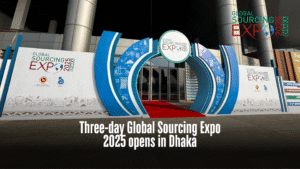
Three-day Global Sourcing Expo 2025 opens in Dhaka
The Global Sourcing Expo 2025 – Dhaka has opened at the Bangladesh-China Friendship Exhibition Centre in Purbachal, bringing together exporters, buyers and trade bodies from across the world in a major push to diversify Bangladesh’s export markets. Jointly organised by the Export Promotion Bureau (EPB) and the commerce ministry, the three-day event is being billed as a strategic international platform showcasing Bangladesh’s evolution from a global apparel powerhouse to a diversified export hub. The expo features products from eight major sectors: readymade garments, leather and leather goods, jute and jute products, agricultural goods, plastics and kitchenware, home décor and furniture, pharmaceuticals, and ICT. More than 100 firms are taking part, including multinational companies, wholesalers and supply-chain representatives. Buyers and sourcing organisations from Afghanistan, China, Iran, Japan, Myanmar, Pakistan, Singapore, Sri Lanka, Thailand, the UAE, the US and several other countries are attending business-to-business meetings and negotiating potential contracts. The fair houses 200 stalls and includes 12 thematic seminars, fashion shows, product demonstrations, and both online and offline networking sessions. Organisers say the event is designed to connect local businesses with global buyers, trade bodies and new market opportunities to accelerate export growth and diversification. Commerce Adviser Sk Bashir Uddin, who inaugurated the expo, said Bangladesh must accelerate diversification, strengthen competitiveness and adopt forward-looking trade policies as it prepares to graduate from the group of least developed countries (LDCs). “To navigate this transition successfully, we must accelerate diversification, improve competitiveness, and adopt forward-looking trade policies,” he said. He added that while graduation is a major achievement, it will gradually reduce the preferential market access and duty benefits Bangladesh currently enjoys. At a seminar on the sidelines of the expo, Mohammad Hatem, president of the Bangladesh Knitwear Manufacturers and Exporters Association, said foreign involvement in port operations could improve efficiency. He also called for suspension of the amended labour law until a newly elected government is in place, arguing that the current changes are neither industry- nor worker-friendly. In another session, Inamul Haq Khan, senior vice-president of the Bangladesh Garment Manufacturers and Exporters Association, stressed the need for easier access to green financing, greater support from brands through knowledge sharing and technology transfer, and targeted interventions for SMEs. He urged wider regional inclusion so that areas such as North Bengal, Sylhet and Chattogram can benefit alongside Dhaka-centric clusters. Khan also called on the government to amplify the industry’s success stories through Bangladesh’s embassies and high commissions abroad, showcasing achievements on the global stage. The expo is being positioned as a vital opportunity for companies aiming to expand exports, launch new product lines or strengthen global brand visibility. With strong government backing for trade and investment, it reflects Bangladesh’s push for product and market diversification at a time when the country is seeking to secure its place in global markets beyond garments. Speakers at the event included Lutfey Siddiqi, special envoy for international affairs to the chief adviser; Mohammad Hasan Arif, EPB vice chairman; Mahbubur Rahman, commerce secretary; and Md Abdur Rahim Khan, administrator of the Federation of Bangladesh Chambers of Commerce and Industry (FBCCI). Organisers say the expo is not only about showcasing products but also about building long-term partnerships. The inclusion of thematic seminars and networking sessions is intended to encourage dialogue on issues ranging from sustainable production and green financing to supply-chain resilience and regional inclusion. The event comes at a critical time for Bangladesh’s economy. As the country prepares for LDC graduation, policymakers and industry leaders are emphasising the need to diversify the export basket, strengthen supply-side capacity and forge new partnerships with international buyers. The expo, they argue, provides a platform to address these challenges while highlighting Bangladesh’s achievements and ambitions. By bringing together stakeholders from across the world, the Global Sourcing Expo 2025 – Dhaka underscores the country’s determination to move beyond its reliance on garments and establish itself as a competitive player in a wider range of industries. Written by Nibir Ayaan
Read More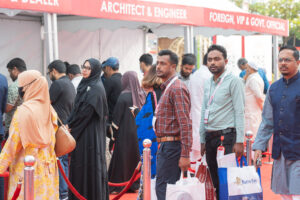
The Ceramic Expo bustling with a large number of people on the 2nd day
Dhaka (28 November 2025): The BCMEA Ceramic Expo Bangladesh 2025 has gathered in the capital. On the second day of this four-day vibrant event, the International Convention City Bashundhara was bustling with local and foreign visitors, exhibitors, businessmen, engineers, architects, and representatives from various companies. The arriving businessmen held meetings with B2B, B2C, and representatives from different companies. In the various pavilions and stalls, they demonstrated their products and ensured spot orders. Senior officials of various companies stated that due to the holiday, there was a noticeable crowd of visitors from the morning, and many placed orders for products. Artist Shahin Mahmud Reza, participating in the fair for the first time, expressed satisfaction with the organization of the fair. As every year, dealer Md. Rahim Uddin has come to the expo from Chittagong. He mentioned that he has seen many new designs at this year’s expo. Following this, a seminar was held in a very large hall where relevant stakeholders participated. Mohammad Khaled Hasan, Deputy General Manager of Sheltech Ceramics Limited, the titled sponsor of the expo, mentioned that the ceramic industry of Bangladesh is a glorious sector. Earlier, we used to import ceramic products at about 80 percent, but nowadays approximately 15 to 20 percent we import; we export it and gradually extend its market. One of the visiting engineers stated that this sector has achieved an average growth of over 20 percent, setting records. Despite the gas crisis, the uninterrupted supply of electricity, and various domestic and international crises, this industry remains an emerging sector. Unlike the ready-made garment, jute, and textile sectors, which receive policy support, this sector has reached a respectable position solely due to the courageous initiatives of entrepreneurs. One could say that the ceramic industry has brought about a silent revolution in the last 10 years. Through rapid expansion in the local market, stable presence in foreign markets, and massive job creation, this industry has demonstrated that with industry-friendly policies, uninterrupted gas supply, and proper branding, it will be capable of exporting billions of dollars in the future solely in Asia. Today, there are about 65–70 ceramic factories and brands in the country producing various products including tableware, tiles, sanitary ware, and electric insulators. As a result, instead of being import-dependent like before, Bangladesh now fulfils a large part of its own demand and sends excess production to the global market; this is not a small change but rather a picture of slow yet steady success in industrial policy. The domestic market for Bangladeshi ceramic products is currently considered to be worth around 70 to 90 billion BDT, with annual growth hovering around 20 percent for a long time. Once where 80 percent of the market was occupied by foreign brands, today local companies meet nearly 85 percent of market demand; in tableware, local participation exceeds 90 percent. Some visitors stated rapid urbanisation, development in the housing sector, rising incomes of the middle class, and changes in lifestyle perspectives have contributed to this achievement. The use of tiles and sanitary products in new flats, shopping malls, hotels, and restaurants is now not just a necessity but also a symbol of prestige and taste. In this way, the ceramic industry has become directly linked to the dreams of the urban middle class, as if the contribution of this industry is silently signing on the walls and floors of every new flat. Although the export earnings of the ceramic industry are still seen by many as ‘less compared to the size of investment’, in reality, it has passed an important initial phase. In the fiscal year 2022–23, the export earnings from ceramic products reached around 43–55 million USD (equivalent to 600–650 crore BDT), which is the highest in four years. The export growth in this sector from 2021–22 to 2022–23 was over 21 percent, although in the fiscal year 2023–24, it has slightly decreased by nearly two percent. Tableware occupies the largest share in the export basket; recently, tiles have also been added. Bangladeshi ceramic products now go to over 50 countries; United States, Canada, Germany, France, Italy, Japan, and various countries in the Middle East are major destinations. In such a reality, despite slight fluctuations, it is clear that Bangladesh is establishing itself as a reliable source of ‘low-cost but quality’ ceramic products in the global market. This expo carries a very high potential for the Bangladeshi ceramic industry and also plays a vital role in the economy. Written by: Mizanur Rahman Jewel
Read More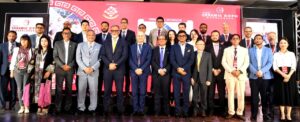
Ceramic Expo Bangladesh 2025 Opens in Dhaka, Showcasing National Industry to Global Markets
A four-day international exhibition has commenced in Dhaka to present Bangladesh’s ceramic industry to local, global buyers and investors. Organized by the Bangladesh Ceramic Manufacturers and Exporters Association (BCMEA), Ceramic Expo Bangladesh 2025, one of Asia’s largest and most influential international ceramic trade exhibitions, is being held at the International Convention City Bashundhara (ICCB). This fourth edition of the expo is set to host 135 companies and 300 global brands from 25 countries, including host Bangladesh, while more than 500 international delegates and buyers are scheduled to participate, underscoring the increasing global focus on Bangladesh’s rapidly expanding ceramic sector. BCMEA confirmed that the exhibition will feature three technical seminars, a job fair, extensive B2B and B2C meetings, live product demonstrations, spot-order opportunities, raffle draws, attractive giveaways, and the launch of new ceramic technologies and products. The exhibition is open to visitors free of charge from 10:00 AM to 6:00 PM daily and is expected to attract buyers, suppliers, and stakeholders from across the sector. Speaking at the opening ceremony, Commerce Adviser Sheikh Bashir Uddin said the industry, once fully dependent on imports, has now secured a strong position in global markets. He stressed the need for advanced technology adoption and uninterrupted energy supply to maintain production efficiency. The adviser added that the Interim Government will provide all necessary policy and regulatory support to accelerate the industry’s expansion. Following the inauguration, the adviser and distinguished guests visited various pavilions and stalls, where they praised the innovations and product displays. The commerce adviser expressed confidence that the sector will become increasingly export-driven. The event was presided over by BCMEA President Moinul Islam. Other speakers included Export Promotion Bureau Vice-Chairman Mohammad Hasan Arif, Italian Ambassador to Bangladesh Antonio Alessandro, BCMEA Senior Vice-Presidents Md Mamunur Rashid and Abdul Hakim Sumon, and BCMEA General Secretary Irfan Uddin. BCMEA President Moinul Islam noted that the ceramic industry has experienced rapid growth over the past decade. More than 70 factories producing tableware, tiles, and sanitary ware are currently in operation, serving a domestic market valued at Tk 8,000 crore annually. Over the last ten years, both production and investment have increased by nearly 150 percent. He added that Bangladesh now exports ceramic products to more than 50 countries, earning nearly Tk 500 crore in annual export revenue. Total industry investment exceeds Tk 18,000 crore, with the sector providing direct and indirect employment to approximately 500,000 workers. He further highlighted that major ceramic-producing nations, including China and India, are increasingly exploring investment opportunities in Bangladesh due to its competitive cost advantages and expanding global footprint. Fair Committee Chairman and BCMEA Secretary-General Irfan Uddin said Bangladeshi ceramic products are gaining international recognition for their quality, durability, and modern design. Demand is rising, and new global markets are opening for local manufacturers. He added that the expo will spotlight next-generation ceramic technologies, including automation, advanced digital printing, robotic handling, and upgraded production lines. “Smart tiles and sensor-integrated ceramic products, which are already popular worldwide, are expected to enter the domestic market soon. This expo will help local manufacturers connect with these emerging technologies,” he said. The event is supported by key industry partners. Sheltech Ceramics is serving as the Principal Sponsor, while DBL Ceramics, Akij Ceramics, and Meghna Ceramics are Platinum Sponsors. Gold Sponsors include Mir Ceramics, Abul Khayer Ceramics, HLT DLT, and SACMI, reflecting broad industry backing for the international expo. Written by: Mizanur Rahman Jewel
Read More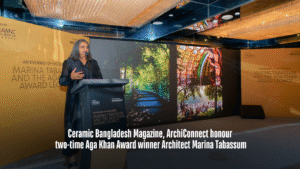
Ceramic Bangladesh Magazine, ArchiConnect honour two-time Aga Khan Award winner Architect Marina Tabassum
Ceramic Bangladesh Magazine, a publication of the Ceramic Manufacturers and Exporters Association (BCMEA), and ArchiConnect, a buildtech platform, honoured Architect Marina Tabassum on Saturday evening, November 8, 2025, Bangladesh’s only two-time winner of the Aga Khan Award for Architecture—one of the most prestigious awards in the world for architects. At the programme, held at the Renaissance Dhaka Gulshan Hotel, the globally acclaimed architect delivered a keynote speech titled “Between Erosion and Emergence”, highlighting different aspects of the projects that brought her international recognition. Before her keynote, Architect Jalal Ahmed, founder and CEO of ArchiConnect, explained why Marina Tabassum’s achievement should be celebrated and how significant it is. He said the Aga Khan Award for Architecture is considered the “Oscar for Architects,” and winning it twice is a phenomenal success for any architect in the world. Later, Marina presented details of her various projects worldwide. Bait Ur Rouf Mosque, completed in 2012 on the outskirts of Dhaka, was the project that earned her the prestigious Aga Khan Award for Architecture in 2016. “Built with locally sourced brick and devoid of traditional Islamic iconography, it offers a contemplative space where worshippers are bathed in natural light,” she said at the event. “The structure is not just a place of prayer—it’s a refuge for a dense, underserved neighbourhood.” She also shed light on one of her most celebrated recent projects, Khudi Bari, a modular, lightweight shelter designed for ultra-low-income populations. The structure, made of bamboo and corrugated metal, can be assembled quickly and relocated as needed. Earlier, Chief Adviser Professor Muhammad Yunus, in a public congratulatory message, echoed this sentiment: “We fondly recall your first Aga Khan Award in 2016 for the Bait Ur Rouf Mosque in Dhaka, a milestone that celebrated the timeless values of spirituality, community, and simplicity in architecture.” “That recognition marked the rise of a Bangladeshi voice of global significance, and your latest achievement further strengthens that legacy.” In 2025, Khudi Bari earned Tabassum her second Aga Khan Award for Architecture, making her the only Bangladeshi architect to win the honour twice. That same year, she was commissioned to design the Serpentine Pavilion in London—an international recognition of her ability to merge local wisdom with global relevance. Later, at the day, an engaging panel discussion was organised on “Marina Tabassum and the Aga Khan Award Legacy”. The session was moderated by Architect Mahmudul Anwar Riyaad, principal designer and director of DWM4 Architects. Distinguished panelists included Architect Professor Fuad Hassan Mallick, dean of the School of Architecture and Design (SoAD) at BRAC University; Architect Professor Zainab Faruqui Ali, chairperson of the Department of Architecture at BRAC University; and Architect Nahas Ahmed Khalil, principal designer at ARC Architectural Consultants. The event concluded with closing remarks by Moynul Islam, president of BCMEA. “We always look forward to creative minds like architects and the brilliance of Architect Marina Tabassum deserves to be celebrated.” Following the panel discussion, mementos were presented to the distinguished panelists and to Architect Moushumi Ahmed, the gracious host of the evening. The honorees—Architect Marina Tabassum, Architect Jalal Ahmed, and Moynul Islam, President of BCMEA—received exquisite woodprint artworks created by renowned artist Professor Anisuzzaman Anis of the Department of Printmaking, Faculty of Fine Art, University of Dhaka Written by CBM Desk
Read More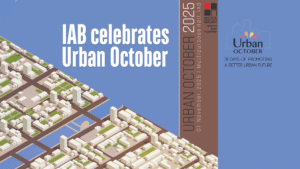
Urban October 2025: IAB Organises Daylong Event, Three-Day Exhibition
The Institute of Architects Bangladesh (IAB) on November marked Urban October 2025 with a day-long celebration at its Multipurpose Hall, bringing together students, professionals, and policymakers to reflect on the future of urban design in Bangladesh. Timed to coincide with World Architecture Day, World Habitat Day, and World Cities Day, the event began at 10:30 am with the opening of a three-day exhibition showcasing student urban design studio projects from architecture departments across IAB-accredited universities. Participating institutions include Bangladesh University of Engineering and Technology (BUET), Bangladesh University (BU), BRAC University (BRACU), Chittagong University of Engineering and Technology (CUET), North South University (NSU), American International University-Bangladesh (AIUB), Ahsanullah University of Science and Technology (AUST), Khulna University (KU), Shahjalal University of Science and Technology (SUST), Dhaka University of Engineering and Technology (DUET), Daffodil Institute of IT (DIT), Southeast University (SEU), Stamford University, State University, and the University of Asia Pacific (UAP). There was a roundtable discussion on “Shaping Cities: The Role and Future of the Urban Design Profession in Bangladesh” led by academicians. The exhibition offers a glimpse into the next generation’s vision for Bangladesh’s urban future, with models and visualisations of cityscapes, transport corridors, and public spaces. At 4:00 pm, the main programme commenced with a roundtable discussion titled “Interference to Planning: DAP”, led by Team Environment & Urbanisation from IAB’s 26th Executive Council. The session addressed concerns surrounding the Detailed Area Plan (DAP) and its implications for sustainable development, zoning, and citizen engagement. The theme for this year’s World Cities Day — “People-centred Smart Cities” —guided the evening’s discussions. A documentary presentation highlighted month-long Urban October activities, including editorial seminars and conventions. Experts and stakeholders then joined a panel discussion, followed by speeches from the chairperson, the chief guest. The event concluded with a vote of thanks. Held under the banner of Urban October, the celebration reaffirms IAB’s commitment to shaping inclusive, resilient, and well-planned cities. As Bangladesh continues to urbanise rapidly, today’s gathering serves as both a showcase and a call to action — urging architects to lead with vision, integrity, and public purpose. The World Cities Day 2025 event ended with the distribution of certificates. Programme Schedule: Location: IAB Office Date: November 1, 2025 Time: Exhibition: 10:30 am Main programme: 4:00 pm Written by Nibir Ayaan
Read More
Cubeinside Design bags DNA Paris Design Awards 2025
Cubeinside Design Ltd, a prominent Bangladeshi architectural and interior design firm, has earned international acclaim after being named one of the winners at the DNA Paris Design Awards 2025—an internationally sought-after recognition for architects and creative people. The award-winning project, Bait Ur Rayyan, is a small-scale mosque designed by Cubeinside, located near the banks of the mighty Arial Kha River in Bangladesh’s Madaripur. The Bangladeshi firm was the consultant for the project, built for the Rokeya Feroza Foundation on a land area of 7,346 square metres. Cubeinside says: “This particular design is an exercise of abstract interpretation of basic symbolism of Islamic architecture. Geometry has been the principal tool for this abstraction in terms of transforming both the form and spatial quality.” The DNA Paris listed Khandaker Ashifuzzaman and Shakhawat Hossain Rocky as the lead designers of Bait Ur Rayyan, which won the award in the Public Architecture category. The annual awards also mentioned Mehri Farnaz, Anis Khan Shanto and Abdullah Al Jaber as members of the mosque’s design team. About the mosque, it was noted on the DNA Paris website: “A human-centric approach created a space for community, keeping the scale sacred yet intimate, using local materials like red bricks, while lights played the most vital role to uplift the spiritual entity of this mosque.” “The concept of ‘Abstract Semiotics’ was applied in measurable mass and space, and other immeasurable aspects with a deeper perceptual level.” DNA Paris, which celebrates the best in global design from over 70 countries, recognises excellence in Architecture, Landscape, Interior, Product and Graphic Design, with entries divided into ‘Professional’ and ‘Emerging’ categories. The latter is reserved for outstanding student work. Farmani Group, a global authority in architecture, design and photography curation, in partnership with In Between, a Paris-based collective of creatives and thinkers, jointly organise the DNA Paris Design Awards. In addition to typology-based subcategories, the most distinguished entries across all five disciplines and both sections are awarded the Grand Prix—the highest honour of the programme. Recipients of the Grand Prix receive a trophy created by Studio Briand & Berthereau, designed to strike a balance between form and function, while addressing the financial and environmental constraints faced by every project. All submissions are evaluated by an expert jury of design luminaries. The jury committee is comprised of designers, editors and creatives who are devoted to true excellence in design. The juries come from different countries, including the UK, the USA, Spain, Argentina, Japan, Sweden, France, Kenya, Thailand, Brazil, Italy, South Korea, Hong Kong, Mexico, Greece and Saudi Arabia. The evaluation of entries is based on a range of criteria that are constantly adapted to current standards. DNA Paris has already announced all winners across different categories for this year, who will be honoured at an event in Paris on October 24. Written by Nibir Ayaan
Read More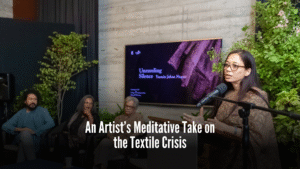
An Artist’s Meditative Take on the Textile Crisis
On 10th October, Bengal Shilpalay’s Quamrul Hassan Hall made room for Yasmin Jahan Nupur’s solo exhibition to breathe in silence. Silence that carries the weight of unspoken resistance, forged over decades. Each corner is equipped with different kinds of soft sculptures and artworks, woven and drawn with bare hands. These sculptures will urge you to zoom in, squint, and at times, resist touching and feeling their texture. The space is surrounded by a variety of installations, including tapestry, jamdani woven in a grid-like matrix, a golden net made of zari threads, Bangla phrases stitched in muslin fabric, and hand-drawn textures and patterns. The sculptures, made from gentle materials like thread and wool, celebrate their natural malleability and softness. Her meticulously executed works on paper using only pen and watercolor draw viewers into their quiet depths. In contrast, Nupur’s brass sculptures defy expectation, transforming rigid metal into forms that appear almost supple. As one takes a closer look, they can find the artist’s sheer brilliance of witty and powerful juxtaposition of delicate threads and robust objects. One of the guests at the opening, globally famous architect Marina Tabassum, who won Aga Khan Award twice, reflected on the powerful presence of silence—describing it as an equally vital element in architecture, a space everyone strives to reach, yet few truly achieve in the process of creation. She observed that Nupur’s works embody that very quality, carrying a quiet strength despite being crafted from simple materials like strand and wool. The softness of Nupur’s sculptures and the intricacies of her work, in fact, carry a more concrete and unsettling truth—illuminating the fading textile legacy of Bengal. Behind these delicate forms lie the stories of countless artisans unable to continue their craft, disrupted not only by economic pressures but also by colonial legacies and ecological changes. A powerful installation in the exhibition was a dazzling hanging burqa. While the traditional burqa symbolizes modesty and concealment, Nupur reimagined it as a three-dimensional form embroidered with gold and silver zari threads—not as a symbol of elegance, but as a testament to distressed endurance. Nupur’s professor, Abul Monsur, recalls how her gentle demeanor during her time at the Fine Arts Institute, CU, fooled him into perceiving her as rather fragile. Her quiet resilience and unwavering devotion to her craft beneath that delicate surface only proved him wrong over time. Yasmin Jahan Nupur not only hails a heavy portfolio of glorious works but also became a household name in the international galleries. This second solo exhibition is Nupur’s careful documentation and a commitment to preserving the vanishing heritage of Bangladesh’s textiles. As visitors walk through the gallery, they are compelled to stop, gaze, and ultimately begin to unravel the silences behind each piece. “Even though the voice may be muted or just a soft whisper (mridu shor), the visitors must take the time to truly listen,” quotes curator Tanzim Wahab. “Unravelling Silence” is on view until November 22, every day from 4 to 8 PM, except Sundays, at Bengal Shilpalay. Written by- Fariha Hossain
Read More
Bangladeshi Hotels, Resorts Win Big at South Asian Travel Awards 2025
Bangladesh’s hospitality sector received a resounding endorsement on the international stage as several leading local hotels, resorts, and tour operators were honoured at the South Asian Travel Awards (SATA) 2025, held at the Cinnamon Grand in Colombo. The glittering ceremony, widely regarded as one of the region’s most prestigious events in the travel and tourism calendar, brought together top-tier organisations from Sri Lanka, India, the Maldives, Nepal, Bhutan, and Bangladesh. A total of 53 Gold Awards and 113 Silver Awards were presented across a range of categories, recognising excellence in service, innovation, and guest experience. Bangladeshi winners spanned multiple categories, reflecting the country’s growing reputation as a destination of choice for regional and international travellers. Award Winners from Bangladesh Baywatch: South Asia’s Best New Hotel and South Asia’s Leading Beach Resort HANSA – A Premium Residence: Leading Designer Hotel/Resort Holiday Inn Dhaka City Centre: Leading City Hotel Intercontinental Dhaka: Leading Luxury Hotel Momo Inn: Leading Family Hotel & Resort and Leading Convention Center Award Platinum Grand: Leading Boutique Hotel Platinum Residence: Leading City Hotel and Leading Budget Hotel Radisson Blu Chattogram Bay View: Best Eco-Friendly Hotel Radisson Blu Dhaka: Leading Airport Hotel and Leading Meeting & Events Sayeman Beach Resort: Leading Wedding Hotel/Resort Sayeman Heritage: Leading Heritage Hotel/Resort The Palace Luxury Resort: Leading Palace Hotel The Peninsula Chittagong: Best CSR Program, Leading F&B Hotel, and Leading Business Hotel The Westin Dhaka: Leading Wellness and Spa Hotel/Resort Bangladesh Tour Group (BTG): South Asia’s Leading Inbound Travel Agent and Best Promotion Campaign in South Asia Travel Classic (Pvt.) Limited: Leading Travel Agent – Outbound Winning awards in different categories was no easy feat. Each submission underwent a rigorous selection and evaluation process. The SATA 2025 Awards were presented to organisations that embody excellence in service delivery, innovation, sustainability, leadership, and overall industry impact. During the evaluation stage, 60 percent of the marks came from the professional judges’ report cards, with the remaining 40 percent from online public voting. Judges scored submissions based on multiple criteria: service excellence, innovation and improvement, customer satisfaction, sustainability and responsibility, operational excellence and safety, sales and revenue performance, leadership and team development, and industry contribution. This year, SATA placed particular emphasis on sustainability, cultural authenticity, and digital innovation. “SATA brings together over 300 delegates from across the South Asian region to celebrate the best of South Asian hospitality brands,” said SATA President Ismail Hameed at a press conference held during the event. He added that international establishments such as the Taj Mahal Palace, as well as brands from Nepal and Bhutan, which are unique in their own right, took part in this year’s show. “From travel agents’ associations to hotel associations to tourism boards — all are part of SATA,” Hameed said. He noted that South Asian destinations hold great tourism potential, offering everything from cool weather and beaches to mountains, heritage, history, culture, food, and delicacies. Md Mohsin Hoq Himel, Secretary of the Bangladesh International Hotel Association (BIHA), who attended the event, said: “BIHA has been working with the South Asian Travel Awards in Bangladesh.” Under the overall guidance of Hakim Ali, founder of BIHA, the association has participated in the prestigious event every year, he said. Through this platform, BIHA aims to highlight the service standards of Bangladesh’s local hotels and resorts, showcasing their uniqueness and distinctiveness alongside other regional hotels, Himel added. “This year, every Bangladeshi hotel and resort has achieved remarkable positions. We extend our heartfelt congratulations to all the award winners.” According to representatives of Bangladesh’s hospitality sector, this international recognition will further advance the country’s tourism and hotel industry in the global market and strengthen Bangladesh’s brand image worldwide, he said. The first edition of the South Asian Travel Awards began in 2016 and has been organised by Highrise every year since, with the support of multiple associations and tourism bodies from across the South Asian region, according to the SATA website. The annual search for South Asia’s most outstanding travel organisations spans a month each year from March to April, calling upon industry professionals to name their preferred travel suppliers in the region who have risen above the competition and surpassed expectations, it read. “The awards programme continues to serve as a platform for nations to come together, not in competition, but in celebration of shared triumphs and brilliance.” Written by Nibir Ayaan
Read More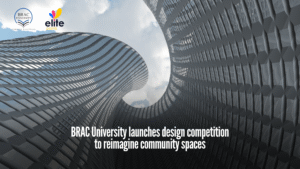
Brac University launches design competition to reimagine community spaces
Brac University’s Department of Architecture, in collaboration with Elite Paint Bangladesh Limited, has announced a student design competition titled Architecture for Unity: Redesigning Community Spaces. The initiative invites architecture students to reimagine public spaces as inclusive environments that celebrate cultural diversity and foster meaningful interaction. The competition is exclusive to students enrolled in Brac University’s Department of Architecture and aims to empower future architects to design with empathy, inclusivity, and sustainability at the forefront. Designing for Diversity and Dialogue According to the official brief, participants are tasked with redesigning a community space—either real or hypothetical—that encourages cross-cultural engagement. The goal is to transform such spaces into vibrant hubs where people from different backgrounds can connect, collaborate, and celebrate shared humanity. The design criteria are both ambitious and socially grounded. Proposals must reflect the cultural richness of the community they serve, integrating elements that honour various traditions while promoting inclusivity. Spatial flow is a key consideration, with layouts expected to guide visitors through the space in ways that encourage movement and exchange. Functional diversity is also central to the brief. The redesigned spaces should accommodate a range of activities—from social gatherings and collaborative projects to quiet reflection—allowing individuals to engage in meaningful ways. Aesthetic appeal, while not the sole focus, remains important. Organisers are looking for innovative architectural techniques and visual storytelling that inspire curiosity and wonder. Sustainability is a non-negotiable component. Students must embrace environmentally responsible design principles that minimise ecological impact, including thoughtful choices in materials, lighting, and energy use. Submission Requirements and Format Participants must submit a comprehensive design proposal that includes conceptual sketches, spatial layouts, and explanatory notes. The drawing submission must be formatted as one A0 portrait sheet in PDF, with a resolution of 300 dpi and a maximum file size of 15 MB. In addition to the visual material, students are required to submit a text document—also in PDF format—describing the idea behind the project, its inspiration, tentative outcomes, and materiality. The written component must not exceed 500 words. All submissions must be in English. File names should follow a strict format: Student’s Name_Student’s ID_Enrolled Semester (e.g., Akibur Rahman_16208023_Fall 2023). Both the drawing and the text document must be uploaded via the designated online submission link before the deadline. Key Dates and Deadlines Registration Deadline: September 1, 2025 Submission Date: October 11, 2025 (by 5.00pm) Jury Date: October 26, 2025 Results Announcement: November 10, 2025 Students can register via the official link: https://forms.gle/ecZtUpRBmVo1jC7M7 Final submissions must be uploaded to: https://forms.gle/z5zhNK88uvH5ncU49 Awards and Recognition The competition offers substantial incentives. The first prize winner will receive BDT 50,000 and a certificate. The second and third place winners will be awarded BDT 25,000 and BDT 15,000 respectively, along with certificates. However, organisers stress that the real reward lies in the opportunity to contribute to a broader conversation about architecture’s role in social cohesion. “This is an ideas competition,” said a faculty member from Brac University’s Department of Architecture. “We’re not asking students to build anything physically. Instead, we want them to think critically and creatively about how architecture can serve as a tool for unity.” Industry Collaboration and Real-World Impact Elite Paint Bangladesh Limited’s involvement adds a layer of industry relevance to the competition. Known for its commitment to sustainable and community-focused projects, the company’s collaboration with Brac University signals a shared vision for inclusive urban development. “This is not just about buildings or parks,” said a spokesperson from Elite Paint. “It’s about creating spaces where people from different backgrounds can come together, share experiences, and build a sense of unity. We believe architecture has the power to shape social behaviour, and this competition is a step towards that vision.” Student Response and Anticipation As the submission window opens, anticipation is building across the Brac University campus. For many students, this competition represents a chance to showcase their design philosophy, engage with pressing social issues, and contribute to a vision of Bangladesh where public spaces reflect the country’s rich cultural mosaic. “We often talk about unity in abstract terms,” said one third-year architecture student. “This competition challenges us to make it tangible—to design spaces where unity is not just an idea, but an experience.” Architecture as a Bridge Between Cultures With its emphasis on cultural celebration, spatial intelligence, and environmental stewardship, Architecture for Unity is more than a student competition. It is a call to action for the next generation of architects to build not just structures, but bridges—between communities, cultures, and futures. Written by Nibir Ayaan
Read More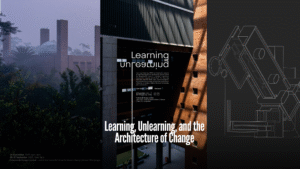
Learning, Unlearning, and the Architecture of Change
In a world where design often races ahead of reflection, CubeInside Design Ltd. is inviting architects, students, and thinkers to pause—and reconsider. Their upcoming three-day event, Learning & Unlearning, promises not just a series of lectures but a journey into the core of architectural consciousness. Set to unfold from September 25 to 27, the event will be hosted at CubeInside Design Ltd. in Dhaka. It’s not a typical seminar. It’s an exploration—into the craft, the culture, and the contradictions of architecture today. CubeInside, known for its thoughtful design practice, has curated this event with a clear intention: to challenge assumptions, provoke dialogue, and open up new ways of seeing. The title itself—Learning & Unlearning—signals a dual movement. It’s about acquiring knowledge, yes, but also about shedding the habits and biases that no longer serve. The programme is structured around lectures, discussions, and exhibitions, each designed to engage participants in critical reflection. Over three days, attendees will encounter ideas that stretch beyond blueprints and facades. They’ll be asked to consider architecture not just as a profession but as a cultural act—one that shapes and is shaped by society. The event is open to students, professionals, and enthusiasts alike. It’s a rare opportunity to engage with architectural discourse in a setting that encourages both curiosity and critique. CubeInside’s invitation is clear: come with questions, leave with more. CubeInside’s announcement, shared via its official Facebook page, carries a tone of quiet urgency. “CubeInside invites you to Learning & Unlearning,” it reads. The event’s visual identity, as seen in the post, is minimal yet evocative. It reflects CubeInside’s design ethos: clarity, restraint, and meaning. There’s no excess—just an invitation to think. What makes Learning & Unlearning stand out is its refusal to be didactic. It doesn’t claim to have answers. Instead, it offers a space where answers can be questioned. In a field often dominated by trends and technicalities, this is a refreshing shift. CubeInside’s initiative is timely. As Bangladesh grapples with rapid urbanisation, climate challenges, and shifting cultural landscapes, architecture must evolve. Events like this help ensure that evolution is thoughtful, inclusive, and grounded. For those attending, the three days will likely be more than an academic exercise. They’ll be a chance to connect—with ideas, with peers, and with the deeper purpose of design. And for CubeInside, it’s another step in its ongoing commitment to architecture that matters. In the end, Learning & Unlearning is not just about buildings. It’s about building understanding. And in that, CubeInside is offering something rare: a space to think, together. Written by Nibir Ayaan
Read More
Industry Leaders Unite for a Greener Bangladesh
A Call for Sustainable Transformation On January 30, 2025, the Sheraton Hotel in Dhaka hosted “Shaping Bangladesh: Designing Tomorrow, Building Today”, a landmark event organised by Ceramic Bangladesh Magazine. It brought together leaders from construction, real estate, and ceramics to champion sustainability and innovation in response to environmental challenges. Thought Leadership for a Greener Future As part of the series “Innovating for a Sustainable Future II”, the multi-panel format featured experts from ceramics, cement, and real estate. Moderated by Dr. Amir Ahmed of Daffodil International University, the panels included Muhammad Badrul Hassan (BBS Cables), Salehin Musfique Sadaf (GPH Ispat), Architect Faysal Ahmed (Concord Real Estate), AKM Ziaul Islam (Magna Ceramic), Mohammad Khorshed Alam (Akij Bashir Group), Asadul Haque Sufyani (Metro Cement), and Babor Hossain (Khadim Ceramics). Key Recommendations for Sustainability Panelists urged greater investment in R&D to reduce reliance on imports and foster local innovation. They called for collaboration across sectors to promote recycled materials and eco-friendly components. Suggestions included using fly ash and slag in cement, adopting hybrid or electric furnaces, and implementing energy-efficient manufacturing. Smart Materials and Policy Reform Experts advocated for smart glass technologies—low-E, solar, and self-cleaning—to boost building efficiency. They also recommended policy reforms to protect local manufacturers from zero-tariff imports and emphasized the need for government-run clay mines to secure raw materials for ceramic production. Bangladesh’s Tile Industry Comes of Age AKM Ziaul Islam highlighted the tile industry’s evolution since 1984. “We started with 100 mm tiles in one color. Now, we export to the USA,” he said. Despite high production costs, innovation has improved working conditions and sustainability, making the industry globally competitive. Real Estate and Domestic Innovation Architect Faysal Ahmed reflected on the sector’s overreliance on imports between 2000 and 2015. He stressed the importance of collaboration among architects, engineers, and academics to develop sustainable materials locally and reduce dependency on foreign technologies. Material Optimization for Environmental Impact Salehin Musfique Sadaf emphasized that optimized material use can reduce emissions and speed up construction. “Using 15,000 kg of cement instead of 20,000 kg without compromising strength means real sustainability,” he explained. Rethinking Cement and Energy Asadul Haque Sufyani discussed the carbon footprint of cement production and promoted fly ash and slag as eco-friendly alternatives. He stressed the need for affordable, sustainable materials and energy-efficient technologies. Energy Crisis and the Future of Glass Mohammad Khorshed Alam raised concerns about gas shortages affecting glass furnaces. He urged investment in hybrid furnaces and advanced technologies and called on architects to incorporate more locally produced glass to avoid overcapacity and unsold stock. Ceramic Bricks: A Smarter, Greener Choice Babor Hossain showcased ceramic bricks’ advantages over handmade red bricks—lower water absorption, higher strength, and reduced structural load. “They were used in national landmarks and can cut construction costs by 13 percent,” he said, advocating for government-run clay mines to sustain innovation. A Unified Path Forward The event concluded with a call for synergy among policymakers, industry, and academia. With rising climate risks and infrastructure demands, embracing innovation is not just strategic—it’s essential. Photo: Courtesy
Read More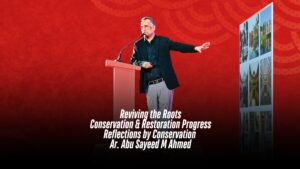
Reviving the Roots: Conservation & Restoration Progress Reflections by Conservation Architect Abu Sayeed M Ahmed
At the anniversary celebration of Ceramic Bangladesh Magazine, esteemed conservation architect and heritage specialist Abu Sayeed M Ahmed presented “Reviving the Roots: Conservation and Restoration Progress”—a heartfelt journey through two decades of architectural conservation across Bangladesh. With vivid images and powerful anecdotes, he reminded the audience that conservation is not about romanticising ruins—it is about safeguarding identity, craftsmanship, and cultural continuity in a nation at risk of forgetting itself. “Every day in Dhaka, a piece of our heritage vanishes. Buildings are bulldozed in the name of development. But without roots, how can we grow a future that is truly ours?” Bringing History Back to Life Nimtali Deuri & Naib-Nazim Museum, Dhaka Abu Sayeed M Ahmed’s first major restoration was the late Mughal-era Nimtali Deuri in Old Dhaka. Hidden under layers of plaster. The restored gateway now houses the Naib-Nazim Museum, commemorating the deputy governors of Dhaka and reflecting a revived connection between the city and its Mughal past. Uttar Halishahar Mosque, Chattogram This 200-year-old mosque was facing demolition for modern expansion. Upon assessment, its authentic Mughal character became evident. Abu Sayeed’s team removed inappropriate cement layers, dismantled an added veranda, and re-clad it in traditional lime and surki. Locals now call it a “Gayebi Mosque”—as if it reappeared by miracle. Nearby, a new mosque by Architect Kashef Mahboob Chowdhury respectfully contrasts the old, echoing its jali motifs in modern concrete. Hanafi Jame Mosque, Keraniganj Once a modest family-owned mosque, it gained global recognition after restoration—winning a UNESCO Award. A new mosque built adjacent to it by Architect Kashef Mahboob Chowdhury, with full visibility of the old structure—offers a striking example of architectural dialogue between past and present, tradition and transparency. Rediscovering Rural Heritage Buraiich Maulvi Bari, Faridpur Neglected and engulfed by vines, this ancestral home seemed destined for ruin. Through sensitive restoration, it has been transformed into a heritage Airbnb, preserving its traditional character while offering economic sustainability. Period furniture, handpicked materials, and contextual storytelling give visitors a window into Bengal’s rural past. Mithamoin Kachari Bari, Kishoreganj This decaying administrative house—once thought beyond repair—was restored to reflect its original civic purpose. From a wild, overgrown ruin, it emerged as a dignified reminder of regional governance and colonial-era architecture, now serving as an active public building. Urban Civic Revival Narayanganj Municipal Building Among Bangladesh’s earliest municipal structures, it was at risk of being replaced. A dual solution—preserve the old and integrate it into the new. Today, it functions as the entrance to the new Nagar Bhaban (City Hall), and plans are underway to convert its upper level into a civic museum. Baro Sardar Bari, Sonargaon A Mughal-Colonial mansion from the Baro-Bhuiyan era, this structure was revived through corporate social responsibility. South Korea-based Youngone Corporation led the project under the leadership of CEO Kihak Sung, who has familial roots in the region. This model highlights how private sector investment can play a crucial role in cultural restoration. Reviving Lost Icons Dhaka Gate (Mir Jumla Gate) Once a neglected and overgrown monument, the historic city gate has been revitalised with its original grandeur—complete with a replicated fire cannon that signals its defensive legacy. Rose Garden Palace, Tikatuli, Dhaka A jewel of Dhaka’s architectural heritage, the Rose Garden was meticulously restored—from stained-glass panels to ornamental plasterwork. Where pieces were missing, they were reconstructed based on archival records, ensuring authenticity over imitation. Hammam Khana, Lalbagh Fort Perhaps the most complex restoration, the Mughal-era bathhouse had suffered colonial and post-colonial misuse. Funded by the U.S. Ambassador’s Fund, the project uncovered a breathtaking pavilion structure, restored lighting from above (true to hammam tradition), and reestablished the original spatial and sensory quality of the Mughal bathhouse. Crafting the Future with the Past Reviving Chini Tikri Ornamentation A rare local tradition, Chini Tikri—the use of broken ceramic dinnerware to form decorative motifs—was resurrected. The team digitally reconstructed patterns, reproduced the plates, broke them and reapplied them by hand. This craft was even adapted into a contemporary mosque in Noakhali, designed by Architect Mamnoon Murshed Chowdhury and Architect Mahmudul Anwar Riyaad, using waste ceramic products donated by Monno Ceramics. These projects demonstrate what is possible when craftsmanship, community, and conservation come together. They are not just restorations—they are cultural revivals, offering spaces where memory, faith, and identity continue to live. Written by Samia Sharmin Biva
Read More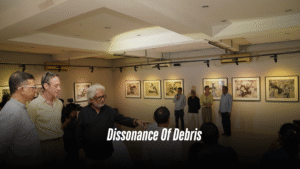
Dissonance Of Debris
From May 17th to 31st, the solo painting exhibition titled “Debris” by Kazi Salahuddin Ahmed adorned the walls of La Galerie, Alliance Française de Dhaka, Dhanmondi. The two-week-long, thought-provoking exhibition featured nearly 30 works on board paper, providing spectators with a glimpse into the artist’s most recent studies. Remembering is a kind of rebellion in Kazi Salahuddin Ahmed’s universe. His solo exhibition, “Debris,” was an uncompromising documentation of human vulnerability. The artist’s recollections of Bangladesh’s 1971 Liberation War seep into modern tragedies—Gaza’s annihilation, the Rohingya exodus, and Kashmir’s stifled cries. The paintings didn’t merely show ruins; they also resurrected spirits. Ahmed’s life had several eras of turmoil. Born within a world transformed by partition and war, his early work in the 1980s was abstract, but the twenty-first century tightened his emphasis. The song “Debris” captures this progression. Each piece is a palimpsest, with layers of pigment representing the strata of history, where erasure and evidence fight silently. Ahmed’s use of board paper as canvas makes a statement in and of itself. Board paper repels, as opposed to ordinary canvas, which absorbs, forcing the artist to handle surface tension. The resulting sculptures have a temporary quality, as if they would disintegrate like the makeshift shelters in Cox’s Bazar’s refugee camps. Though anchored in Bangladeshi stories, “Debris” speaks to a lexicon of global migration. The exhibition’s centerpiece, “Babel Fragment” (2024), depicts the mythological tower as a jagged silhouette against a sulfurous hue. Its shattered planes evoke both bombed-out Aleppo and the decaying tenements of Old Dhaka. Ahmed, who has flown from Paris to Islamabad, appears to imply that rubbish knows no boundaries. In “Eclipse of Return” (2024), a skeletal stairway rises into the emptiness, its steps fractured like vertebrae. Nearby, “Archive of Dust” displays a child’s sneaker half-buried in a thick texture that mimics charred dirt “The utter erasure of Gaza, which was once full of life; the ongoing miseries of people in Kashmir; or the hopelessness faced by displaced Rohingyas attempting to make a living in camps in Chattogram—all of this jostles the mind as one attempts to ponder the future of the human race. Furthermore, it is difficult to leave behind the legacy of Bangladesh’s repeated failures to shape a future. The people’s desire for political stability has always been a never-fulfilled dream in our country. The demise of the authoritarian dictatorship has undoubtedly allowed everyone to focus on a future beyond the current system, but it appears that things are still breaking apart, leaving us with only emotional rubble,” observed famous art critic Mustafa Zaman. The intimacy of “Debris” sets it apart from other forms of protest art. In “Letters Unsent,” bits of Urdu and Bangla letters emerge behind layers of gray, like voices muted by time. The piece is similar to Ahmed’s 2018 series on refugee diaries, but the language is virtually illegible—a metaphor for history’s selective memories. Written By Shahbaz Nahian
Read More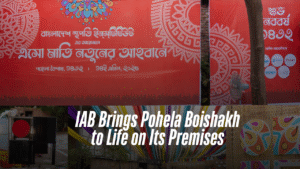
Institute of Architects Bangladesh Brings Pohela Boishakh to Life on Its Premises
The Institute of Architects Bangladesh (IAB) welcomed the Bengali New Year in vibrant style, hosting its first-ever Pohela Boishakh celebration on its premises. Titled “Esho Mati Notuner Ahobane”, the event was a colourful and cultural affair that reached beyond the architectural fraternity. Architects’ spouses, children, and extended family were warmly welcomed. The idea was simple: to celebrate the new year and the people who stand behind the scenes of every great architect. Festivities began at 3 PM, as the rhythmic beat of traditional dhol set the tone. Architect Asif M Ahsanul Haq, Convener of the Bengali New Year Celebration Committee, opened the event, inviting everyone into the heart of the celebration. With warm smiles and colorful attire, attendees embraced the spirit of community and enjoyed the laughter and tradition with their extended family. The IAB grounds were transformed into a festive fair, with interactive cultural corners drawing crowds throughout the day. Children gathered around clay artists and potters, their hands deep in clay, learning to mold traditional shapes. Nearby, shitol pati (cooling mat) weavers demonstrated their age-old techniques, encouraging young participants to try their hand at weaving. A painting zone was also set up, where children were free to create without the pressure of competition. Their artwork was later displayed, showcasing unfiltered creativity and color. Laughter echoed from the crowd gathered around the Putul Nach (puppet dance) and magic show, where entertainment delighted audiences of all ages and reminded everyone of the charm of folk performances. At the heart of the event was a bustling Meena Bazaar, alive with the flavors of tradition. Stalls served familiar favorites—muri, murki, naru, moya, samosa, beguni, lemonade, and kacha aam er shorbot—while architects and their families showcased their creative talents through stalls featuring homemade food, traditional sarees, books, paintings, and handmade crafts. It was a beautiful blend of personal passion and cultural pride. Major industry sponsors, including Berger Paints Bangladesh, Italiano Marble and Granite, Indigo Marble and Granite, Tilottoma Group, and Space Couture, added their own festive touch. Their vibrant booths offered free face art, portrait sketches, and a variety of Bengali snacks and refreshments, contributing to the lively spirit of the day. As the sun began to set, the stage came alive with folk songs and traditional dances performed by members of the architectural community. The soulful performance by Sadhu Songo, a renowned Lalon music troupe, captivated the audience with its spiritual melodies. The evening came to a heartfelt close with a collective rendition of “Esho He Boishakh,” followed by heartfelt closing remarks from Professor Dr. Abu Sayeed M Ahmed, President, and Professor Dr. Masudur Rashid, General Secretary of the Institute of Architects Bangladesh. The night concluded with a warm, memorable dinner under the open sky—an evening to remember. This landmark celebration was not just about welcoming a new year, it was about embracing shared roots, honouring cultural expression, and celebrating the bonds that make up the architectural community.
Read More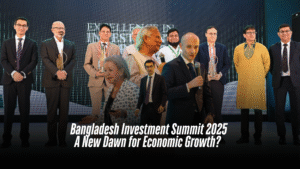
Bangladesh Investment Summit 2025 A New Dawn for Economic Growth?
Bangladesh now stands at a critical crossroads. As the country prepares to transition from a least-developed nation (LDC) to a middle-income economy in 2026, it grapples with significant hurdles. Despite years of economic resilience, enduring issues—such as import dependency, skill shortages, stagnant private investment, and declining foreign direct investment (FDI)—continue to slow progress. In this challenging environment, the Bangladesh Investment Summit 2025 emerged as a pivotal event, unveiling initial investment proposals worth Tk 31 billion (3100 crore) and igniting cautious optimism among policymakers and investors. Convergence of Promise and Challenges Organized by the Bangladesh Investment Development Authority (BIDA), the four-day Dhaka summit, held from April 7 to April 10, 2025, brought together over 550 investors and business representatives from more than 50 countries. Inaugurated by Chief Advisor Dr. Muhammad Yunus, the summit sought to reimagine Bangladesh’s global investment identity even as it faced structural challenges. Ultimately, the success of these initiatives will hinge on whether early commitments evolve into sustained and tangible investments. For years, Bangladesh’s investment landscape has remained largely stagnant. Overall investments have hovered between 24–28 percent of GDP, with private investment stuck at 22–24 percent and FDI persistently below 1.0 percent. Recent declines in private investment in FY2023 and FY2024, along with a continuous drop in FDI since FY2018, have been attributed to bureaucratic hurdles, policy unpredictability, and macroeconomic instability—particularly in managing exchange rates. Yet, amid these challenges, the summit has sparked a renewed sense of hope. Global Multinationals Betting on Bangladesh Three major international companies announced expansion plans during the summit: Inditex (Spain): The retail giant behind Zara reaffirmed Bangladesh’s role as a key sourcing hub and hinted at increased procurement. Lafarge Holcim: The cement leader discussed plans to broaden operations and explore carbon capture initiatives. Handa Industries (China): The company committed $150 million to develop textile, dyeing, and garment units in designated economic zones. In addition, Dubai-based DP World expressed interest in investing in Chattogram’s new Mooring Container Terminal. Celebrating Local Champions Local enterprises also received significant recognition at the event. Four Bangladeshi firms were honored for their contributions: bKash (Excellence in Investment): The trailb lazing mobile financial services provider backed by IFC, Ant Group, and SoftBank. Fabric Lagbe (Innovation Award): A digital marketplace that empowers traditional weavers. Walton (ESG Award): A leading local electronics manufacturer exporting to over 40 countries. Square Pharmaceuticals (Investment Excellence): A company that has grown from modest beginnings in Pabna to a globally recognized pharmaceutical powerhouse. These success stories underscore that, despite systemic challenges, Bangladeshi enterprises can thrive on the international stage. Global Investors Show Confidence There is growing international faith in Bangladesh’s revised approach to investment. Foreign investors have commended the interim government for taking proactive measures to attract FDI—a marked departure from previous administrations. A delegation of 60 investors from the U.S., South Korea, China, Japan, India, Australia, and the Netherlands toured key hubs such as the Korean Export Processing Zone (KEPZ) in Chattogram and the Japani Export Processing Zone (JEPZ) in Narayanganj, exploring opportunities in textiles, IT, and manufacturing. KEPZ: A Model Investment Hub Operated by South Korea’s Youngone Corporation, KEPZ has become a shining example of Bangladesh’s readiness for FDI. Investors were impressed by its well-established infrastructure, efficient licensing procedures, and worker-friendly amenities—including a hospital, a textile institute, a 40MW solar project, and an effluent treatment plant. With $700 million already invested, KEPZ now hosts 48 factories and employs 30,000 workers, 75 percent of whom are women. Forging Sustainable Partnerships The summit also facilitated key agreements. Notably, BIDA, the Commerce Ministry, ILO, and UNDP issued a joint declaration to promote sustainable and inclusive growth through targeted trade reforms. Additionally, UK Trade Envoy Baroness Rosie Winterton highlighted long-term opportunities in healthcare and education, paving the way for enduring global partnerships. Navigating the Road Ahead: Can Bangladesh Overcome Its Investment Slump? Despite the summit’s positive momentum, Bangladesh’s investment climate continues to face obstacles: High bank interest rates that deter private borrowing. Policy inconsistencies under the interim government create uncertainty. Weak FDI performance compared to regional competitors like Vietnam and India. Analysts stress that without significant structural reforms—streamlining bureaucracy, ensuring policy stability, and stabilizing the macroeconomy—Bangladesh may struggle to sustain the anticipated investment surge. Execution is Key The Bangladesh Investment Summit 2025 has successfully rebranded the country as an emerging investment destination. With multinationals such as Inditex, Lafarge Holcim, and Handa Industries pledging expansion and local leaders like bKash and Walton proving their global competitiveness, there is considerable cause for optimism. However, the real challenge now lies in execution. Only if Bangladesh addresses its business environment hurdles, refines regulatory frameworks, and maintains macroeconomic stability can this new momentum herald a transformative economic chapter. For now, the world watches closely—will Bangladesh seize this moment, or will these early promises fade away? Only time will tell. Written by Sajibur Rahman
Read More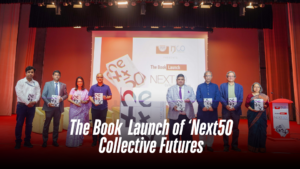
The Book Launch of ‘Next50: Collective Futures
A significant milestone in shaping Bangladesh’s future was marked today with the official launch of Next50: Collective Futures at BRAC University’s Multipurpose Hall. This landmark publication—the largest edited volume on Bangladesh’s built environment—brings together 81 authors, including many from the Bangladeshi diaspora, to explore the nation’s next five decades of progress, innovation, and connectivity. Spanning 49 chapters across nine major themes, the book examines urban and rural transformation, infrastructure, climate resilience, housing, governance, and technological innovation. Written in accessible language for policymakers, practitioners, and the general public, it bridges cutting-edge research with real-world impact, making complex ideas actionable for those shaping the nation’s future. The event was attended by some of Bangladesh’s most prominent architects, planners, and urbanists from both academia and professional practice. Distinguished guests included Dr. Syed Ferhat Anwar, Vice-Chancellor of BRAC University, and Mohammad Azaz, Administrator of Dhaka North City Corporation, who underscored the urgency of visionary thinking in driving sustainable and inclusive development. The program featured a compelling book introduction by Professor Fuad H. Mallick, Editor-in-Chief of Next50 and Dean of the School of Architecture and Design at BRAC University, followed by an insightful review from Dr. Mohammed Zakiul Islam, Professor at BUET, who highlighted the book’s interdisciplinary approach and its relevance to Bangladesh’s rapidly evolving urban landscape. Adding to the discussions, key stakeholders, including representatives from Shah Cement, reflected on the private sector’s role in shaping the built environment. The event concluded with remarks from the book’s executive editors, Dr. Tanzil Shafique and Dr. Saimum Kabir, who emphasized the collaborative effort behind the publication and its potential to influence future policies and practices. Shah Cement also expressed interest in future collaborations. Beyond the discussions, the launch served as a key networking platform for scholars, policymakers, and industry leaders, fostering dialogue and collaboration on the country’s long-term development. Attendees engaged in meaningful conversations over Iftar and dinner, reinforcing the event’s role in strengthening professional and intellectual ties. Organized by Open Studio and Context BD, with support from Shah Cement, the event also reached a wider audience through a live stream, ensuring broader engagement with the book’s mission.
Read More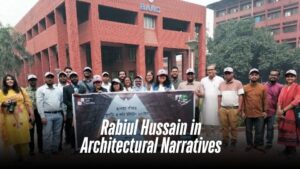
Rabiul Hussain in Architectural Narratives
On February 28, 2025 Bangladesh Institute of Architects (IAB) and the Bangladesh Liberation War Museum organized a day-long program to tribute architect Rabiul Hussain through visiting 3 of his projects- Bangladesh Agricultural Research Council (BARC), Jalladkhana Killing Ground and Jahangirnagar University. and taking a vow to protect the diversified works of the architect. Architect Rabiul Hussain (January 31, 1943 – November 26, 2019) was a prominent Bangladeshi architect, poet, art critic, short story writer, essayist, and cultural activist. A person of multifaceted talent, honored by the Government of Bangladesh with the Ekushey Padak for his contributions to language and literature in 2018, received the Bangla Academy Literary Award for his contributions to poetry in 2009, and the Bangladesh Institute of Architects (IAB) awarded him the Gold Medal for his outstanding contribution to architecture in 2016. He served four times as the President of the Bangladesh Institute of Architects, Vice-Chairman of the Architects Regional Council of Asia (ARCASIA), Vice-President of the Commonwealth Association of Architects, and President of the South Asian Association for Regional Cooperation of Architects. In addition, he was a trustee of the Liberation War Museum, an executive member of the 1971 Ghatok Dalal Nirmul Committee (Committee for Elimination of Martyrs’ Assassination), and made significant contributions to the preservation of the memories of the Independent War of Bangladesh. Although he was born in the village of Ratidanga in Shailkupa Upazila, Jhenaidah District, he completed his secondary and higher secondary education in Kushtia District. Later, in 1968, he earned his Bachelor degree in architecture from the then East Pakistan University of Engineering (now Bangladesh University of Engineering and Technology). After obtaining the graduation, he began his professional career as an architect working with architect Mazharul Islam and later joined Shahidullah Associates. Alongside his architectural practice, he also maintained a strong passion for writing. Throughout his career, he served as a life member of the Bangla Academy, and was involved in various organizations, including the Central Kachi-Kachhar Mela (a children’s and youth organization), the National Poetry Council, the Bangabandhu Sheikh Mujibur Rahman Memorial Museum, the International Film Critic Association of Bangladesh, and the Bangladesh Institute of Architects. Notable buildings designed by him include the Jalladkhana(Execution House), the Bangladesh Agricultural Research Council building, the entrance gate of Dhaka University, the Liberation and Independence Arch, the Jahangirnagar University gate, the Bhashani Hall, the Bangabandhu Hall, the Sheikh Hasina Hall, the Khaleda Zia Hall, the Wazed Mia Science Complex, the auditorium and academic building complex of Chittagong University, and alongside architect Mazharul Islam, the Bangladesh Agricultural Research Institute in Gazipur, Haji Mohammad Danesh Science and Technology University in Dinajpur, and polytechnic institutes in Chittagong and Khulna, among others. Bangladesh Agricultural Research Council (BARC) The Bangladesh Agricultural Research Council (BARC) was established in 1973 with the aim of conducting agricultural research and coordinating various related institutions in Bangladesh. Almost a decade after its founding, in 1982, architect Rabiul Hussain designed its current building. The design process, which began in 1978, spanned nearly four years. In a remarkable way, he crafted a unique architectural design using red brick masonry that harmonized with Bangladesh’s climate, nature, and way of life. This building is a symbol of post-independence architecture, reflecting a search for an architectural style; that is free from the burden of colonization in a newly liberated land. Each detail of the building echoes the same vision. The regional architectural influence of Maestro Mazharul Islam, the pioneer of Bangladesh’s regional architecture, is evident in the design, which he was fortunate to experience starting from his third year of architectural education. The building, located on a site shaped like the letter ‘L’ in the English alphabet, is easily noticeable among surrounding roads and structures. It stands at the junction of Airport Road and Khamar Bari Road, near Farmgate and Bijoy Sarani. The design symbolizes various aspects of aesthetic gravity, marking an early effort in the evolution of post-independence Bangladeshi architecture and the search for a Bengali “identity” in the country’s-built environment. The location of the building, near the capital’s main international airport at Tejgaon, limited the building’s height to four floors. The rectangular building, measuring 223 feet in length and 63 feet in width, has a total built-up area of 32,700 square feet. It is aligned along the east-west axis and is equipped with optimal provisions for cross-ventilation and prevailing south winds. The three-story building is vertically divided into three functional zones. The first floor is allocated for administrative offices; the second floor houses the executive branch. The third floor features a 7,500-square-foot conference room with seating for 280 people at its center, along with a 1,350-square-foot library and a meeting room. The first and second floors are organized along a double-loaded corridor, with two staircases at the eastern and western ends of the building. In harmony with local traditions, the roof was projected to protect the building from torrential rain and scorching sun. The BARC building essentially consists of two parts: one is the brick-clad inner shell that spans the main area, while the additional levels moderate the harsh tropical sun and protect the building during the monsoon season. Architect Mazharul Islam’s office- Vastukalabid was a key influence in experimenting with such a critical combination of climate consideration and modernist aesthetics along with that of brick mason for architect Rabiul Hussain and many young architects in the early 1970s. To give an example, his designs, including the National Institute of Public Administration (1964), encouraged a generation of architects to explore “critical regionalism” through a lens that considered climatic aspects in the visual language of architecture. Since stone is rare and fired bricks can be produced in abundance from local clay, architects saw bricks as an unprecedented symbolic representation of the delta and its culture. Representing the soil of the riverine country, bricks were the purest or most organic building material believed by the Bangladeshi architects. The “poetry” of bricks is hard to miss in the concept and construction of the BARC headquarters building. Also, the influence of
Read More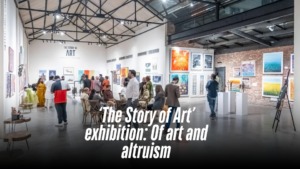
‘The Story of Art’ exhibition: Of art and altruism
Organized by Dhaka Storytellers from February 8 to February 13, the lush gallery space Aloki Greenhouse in the capital’s Gulshan hosted an exhibition titled The Story of Art. The exhibition boasted a stunning collection of 80 to 90 artworks, captivating audiences for a week. Curated by Syeda Adiba Hussain, co-founder of Dhaka Storytellers, The Story of Art was more than just a display of artistic excellence. This was Dhaka Storytellers’ second art event, following the charity exhibition Art for Charity in August 2024. In the same vein, The Story of Art supported a larger cause, with a portion of the proceeds donated to five schools and one college in Sylhet, demonstrating the power of art to create tangible change beyond gallery walls. Beyond the beauty of its displays, the exhibition underscored the immense power of art to inspire and drive change. By merging artistic excellence with humanitarian efforts, it aimed to uplift communities, empower individuals, and support crucial social causes. Having been in the making for almost a year, the exhibition was carefully planned to bring together some of Bangladesh’s most celebrated artists. The lineup included some of the country’s most notable names, such as Rafiqun Nabi, Monirul Islam, Hamiduzzaman Khan, and Kanak Chanpa Chakma. Furthermore, the exhibition commendably featured artworks by several emerging artists, creating a dynamic collection that bridged generations of artistic expression. From simply beautiful paintings to thought-provoking sculptures, The Story of Art was also an opportunity for both seasoned and budding collectors to acquire unique pieces while contributing to a noble cause. The grand opening on Friday, February 7, set the tone for the week-long exhibition. The launch was attended by an invitation-only audience, including the participating artists, their families, media professionals, and notable guests. As the exhibition drew to a close, it left behind more than just a collection of breathtaking visuals; it also left an indelible impression on those who visited. The fusion of artistic expression with social commitment deeply moved attendees, inspiring them to consider the vast potential of art beyond aesthetics. The exhibition carried a narrative that extended far beyond the gallery walls, reinforcing the idea that art is not merely to be observed but to be experienced, felt, and acted upon. The event was about more than just admiring artworks—it was about creating a shared vision where artists, curators, and spectators all committed to a cause bigger than themselves. It demonstrated that art has the ability to transcend traditional boundaries, reaching into the hearts of individuals and communities, sparking conversations, and inspiring action. Ultimately, The Story of Art was a celebration of creativity’s ability to inspire, connect, and transform lives. The week-long show was a powerful testament to the transformative synergy between art and altruism. It showcased how art exhibitions, when intertwined with a greater purpose, can spark meaningful change. Written By Shahbaz Nahian
Read More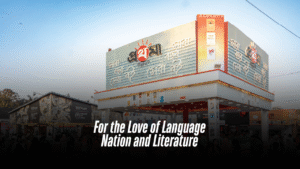
For the Love of Language Nation and Literature
With a new sun, new authorities emerge, revitalising familiar spaces. The 40th Ekushey Book Fair 2025, themed “July Mass Uprising: Building a New Bangladesh (New Bangladesh Deconstruction),” featured over 700 publishing houses at the premises of Bangla Academy and Suhrawardy Udyan. The month-long fair was inaugurated by Dr. Muhammad Yunus, the Chief Adviser of the interim government on 01 February. The Amar Ekushey Book Fair, a fundamental element of Bangladesh’s literary heritage, returned this year with a striking and visually captivating transformation. Uniquely crafted stalls add an architectural charm that sets this year’s fair apart from the previous editions. Visitors are greeted with the richness of literature and an impressive array of architecturally designed stalls, each presenting a unique identity. The influence of the new government is evident in the fair’s structured setup, where each stall showcases unique aesthetics through bold shapes, intricate exteriors, and thematic designs. When visiting this year’s Ekushey Book Fair, the crowd was astounding. People of all ages turned the fair into a true celebration. The entrance was bustling with various food vans, and women and children were all dressed up. The Book Fair has never been this festive and crowded in recent years, even on working days. Whether for recreation or out of love for books, the fair should continue in this spirit for eternity, celebrating Bangla language and literature. Readers and visitors took a moment to admire the aesthetics embraced by publishers who dedicated extra time and thought to beautifully decorate their pavilions. One of the highlights of this year’s book fair is the pavilion by Iti Prokashon, titled ‘Ziar Bari’ (Zia’s House), named after Ziaur Rahman, a prominent army chief, freedom fighter and politician who served as the sixth President of Bangladesh from 1977 to 1981. A key figure in the country’s War of Independence, Zia’s name has often been sidelined in public discourse and textbooks due to the agendas of the previous autocratic regime. In contrast, Onnodhara Prokashon transformed its pavilion into a representation of the Bangladesh Parliament House. The sight of these two distinct symbols coexisting on the same ground truly captivated visitors. Afsar Brothers gave their pavilion a harmonious blend of heritage and functionality, making it an inviting space for book lovers while paying homage to Bengal’s rich architectural traditions. The structure follows a half-timbered design with exposed wooden beams and white infill panels, resembling classic Bengali rural or zamindari house styles. Other notable mentions include Bishwa Shahitto Kendro, which transformed its pavilion into a two-story BRTC bus structure, paying homage to its Moving Library. Bhashachitro Publications adopted a minimal, monochrome palette, giving the pavilion a simple yet elegant look. Bengal Books chose a wooden pavilion, creating a soothing atmosphere for buyers with its well-decorated books and thoughtful lighting. The Puthiniloy stall featured a book-structured roof, while Gronthik designed its stall to resemble a mud house with bamboo. Shaishab Prakash’s stall is shaped like a whimsical castle, inviting readers into a world of children’s literature. These creative designs add a unique visual and conceptual dimension to the fair, making it not just a place for purchasing books but also for cultural and artistic appreciation. The best pavilion design goes to Batighar, designed by artist Shahinur Rahman. The triangular front featured a stained-glass-like panel with motifs from Nakshi Kantha and Patachitra, reflecting Bengali folk art. Inside, a red dome element, inspired by a Chhoto Sona Mosque, highlighted local heritage. The steeply pitched roof with exposed red clay tiles resembled traditional Bangladeshi huts. For its artistic excellence, Batighar won the Kayum Chowdhury Memorial Award for best pavilion in this year. Sadly, the kids’ section lacked vibrancy, with limited space for children to explore and freely roam around. However, a few stalls, including Shoishob Prokash, Mayurpankhi, and EKRI MIKRI, did a decent job of capturing the attention of young visitors. Shoishob Prokash transformed its stall into a castle-like structure, Mayurpankhi adhered to its palette with subtle adjustments, and EKRI MIKRI added a creative touch by placing a horse for children to play on, making the stall an engaging and fun experience for the little ones. This year, the fair included 66 more stalls than the previous year. 99 publishers were located at the Bangla Academy premises and 609 at the Suhrawardy Udyan area. There were 37 pavilions in total, with one at the Bangla Academy premises and 36 at Suhrawardy Udyan. The Little Magazine Corner had been set up in Suhrawardy Udyan, with 130 stalls. In the children’s corner, 74 institutions had been allocated. The fair also featured daily seminars and cultural programmes in the evening, and a special “Children’s Hour” held every Friday and Saturday from 11am to 1pm. As part of the Amar Ekushey celebrations, various children’s competitions, including art, recitation, and music, were organised. The fair had four entrance points: TSC, Doyel Chattar, MRT station, and Engineering Institute. Director General of Bangla Academy Mohammad Azam and Member Secretary of the Fair Management Committee Sarkar Amin said to Ceramic Bangladesh that the fair was entirely polythene and smoking-free, with security provided by the Police, RAB, Ansar, and various intelligence personnel. All participating institutions sold books on a 25% commission basis. The academy published 43 new books and reprinted 41 books for this fair. A total of 3,300 new titles were published in this Book Fair 2025 and Bangla Academy stall alone sold books worth Tk 61 lakh. Several awards were presented at the fair, including the Chittaranjan Saha Memorial Award for the best publisher, the Munir Chowdhury Memorial Award for artistic excellence, and the Rokanuzzaman Khan Dadabhai Memorial Award for children’s literature. These awards recognise the contributions of publishers and authors to the literary and cultural landscape of Bangladesh. Written By Fariha Hossain
Read More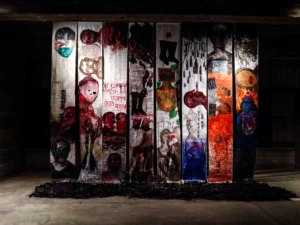
Body and the Map: Of wounds and Hope
Beautifully curated by Sharmillie Rahman, the exhibition “Body and the Map” took place on Bengal Shilpalay between 15 and 28 December, 2024. By engaging viewers to contemplate the interaction of power, identity, and transition, “Body and the Map” was more than just another decent exhibition that had the July-August uprising as its subject matter; the exhibition not only acted as a stark reminder about what must not be forgotten but also intrigued the audiences to introspect. Consisting of the artworks of ten multidisciplinary artists, many of whom were active participants in the mass uprising that overthrew a long-standing regime, “Body and the Map” was a riveting look at societal upheaval in the aftermath of that student-led mass rebellion. The show, based on the collective memory of Bangladesh’s last July-August, is both a reflection and a debate about the force of resistance, the weight of trauma, and the possibility of change. Their work delves into the complicated reality of a country dealing with its old and fresh scars and the tiers of collective psychological state of the mass after the newfound independence. The participating artists were A. Asan, Afsana Sharmin, Ashang Mong, Farzana Ahmed, Mong Mong Shay, Niazuddin Ahmmed, Palash Bhattacharjee, Rasel Rana, Razib Datta, and Ripon Saha. The July-August uprising was characterised by an unprecedented feeling of urgency, as residents defied persecution to demand justice, equality, and dignity. However, the road to liberation came at a high cost, with bodies mutilated, lives lost, and a collective psyche permanently transformed. The show explores this dichotomy, emphasising the body as both a personal and societal vessel for history, pain, and resilience. The artworks that were adorned by the gallery space delve deeply into the concept of the body as a source of memory and resistance. Whether through physical depictions or abstract interpretations, the ten artists highlighted how the human body bears the weight of institutional injustice and governmental violence. The visual narratives starkly remind us about biopolitical disposability, demonstrating how individuals became victims of normalised violence during the authoritarian system. The relationship between body and land appears as a repeating pattern, emphasising identities defined by culture, religion, race, and gender, all of which intersect within a nation’s sovereign borders. However, these links are loaded with tension, since the scars of authoritarian authority and systematic impunity are etched on both the body and map. In the aftermath of this historic movement, “Body and the Map” illustrated the dialectics of trauma and renewal, hopelessness and optimism. The exhibition stressed the importance of open discourse and the reframing of identity and government as centralised power disintegrates and something new emerges. Despite recollections of terror, violence, and loss, the artworks elicit a cautious hope. The collective body politic, though scarred, remains resilient, signalling a determination to redefine itself and the map it inhabits. Written by Shahbaz Nahian
Read More
A Brilliant Conclusion with Countless Accolades Ceramic China 2024 Unfolds a New Chapter of Cooperation
On June 18–21, 2024, CERAMICS CHINA 2024, with “Great Minds to Lead, Digital Intelligence for Brilliancy” as the theme, concluded successfully in extensive praise. This edition is jointly organized by seven entities, including China National Light Industry Council (CNLIC), China Building Materials Federation (CBMF), China Building Ceramic and Sanitaryware Association (CBCSA), China Ceramic Industry Association (CCIA), CCPIT Building Materials Sub-Council (CCPITBM), Unifair Exhibition Service Co., Ltd. and Beijing Jianzhan Technology Development Co., Ltd., thereby, the long-standing “Organizing Ceramics China by turns” has concluded, showcasing the strong influence and multifaceted benefits of the partnership between five national associations and two exhibition companies through united cooperation and resource integration. This act of union has drawn widespread industry attention and positive responses. Mr. Chen Guoqing, Executive Vice President of CBMF and President of CCPITBM, highly praised the collaborative efforts of the seven organizers in presenting this unprecedented exhibition and expressed sincere gratitude to all the exhibitors, visitors, buyers, and the media partners for their continued support for CERAMICS CHINA over the years. Mr. Du Tonghe, Vice President of CNLIC and President of CCIA, expressed full affirmation of the seven organizers for jointly holding the exhibition: “This is a powerful measure in line with the forward trend of the new era, promoting high-quality development in the ceramic industry, and giving full play to the role of the ‘national team’ of the ceramic industry. It has gained extensive industry support.” Ms. Han Xiuping, Managing Director of Unifair Exhibition Company urged industry peers to strengthen cooperation, unite efforts, and jointly propel the industry towards premium, smart, green, and integrated transformation for high-quality development.
Read More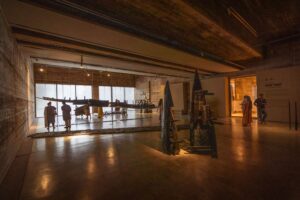
Through the eyes of artist Wakilur Rahman
A video shows Mr. Rahman in the hall with his exhibits, elaborating on his interpretations as remnants of his journey. “The exhibits are a reflection of my journey with art at different times,” he said, as the camera moved to show the hanging base of a traditional riverine boat. Wakilur Rahman has been working with social issues through his artwork since the 80s. He has recently hosted an exhibition by the name “Monon Khonon” at Bengal Shilpalay. It visualized through installments, the cultural aspects that portray the life in the delta regions. The acclaimed artist often ponders over the contour of our thoughts, imaginations, and emotions, and digs into this diversity in people from different regions. Going through the artwork in the exhibition one noticed a dark theme over three earthly elements: A fragment of the exhibition focused on wet mud and imprints on wet mud. The artist believes that mud is instilled in our physical molding and is a crucial part of life. Upon entrance one is greeted by the bottom half of a boat which depicts the enthusiasm of the artist as “Tori” is widely used in Bengali culture and its music. The final material in use is language which is represented by 3 dimensional prints and represents communication.
Read More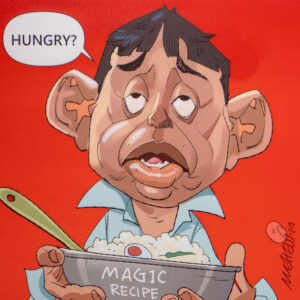
Cartoon e Bidroho’- A bloodshot rebellion portrayed in art!!
Cartoon e Bidroho’- A bloodshot rebellion portrayed in art!!
Read More
